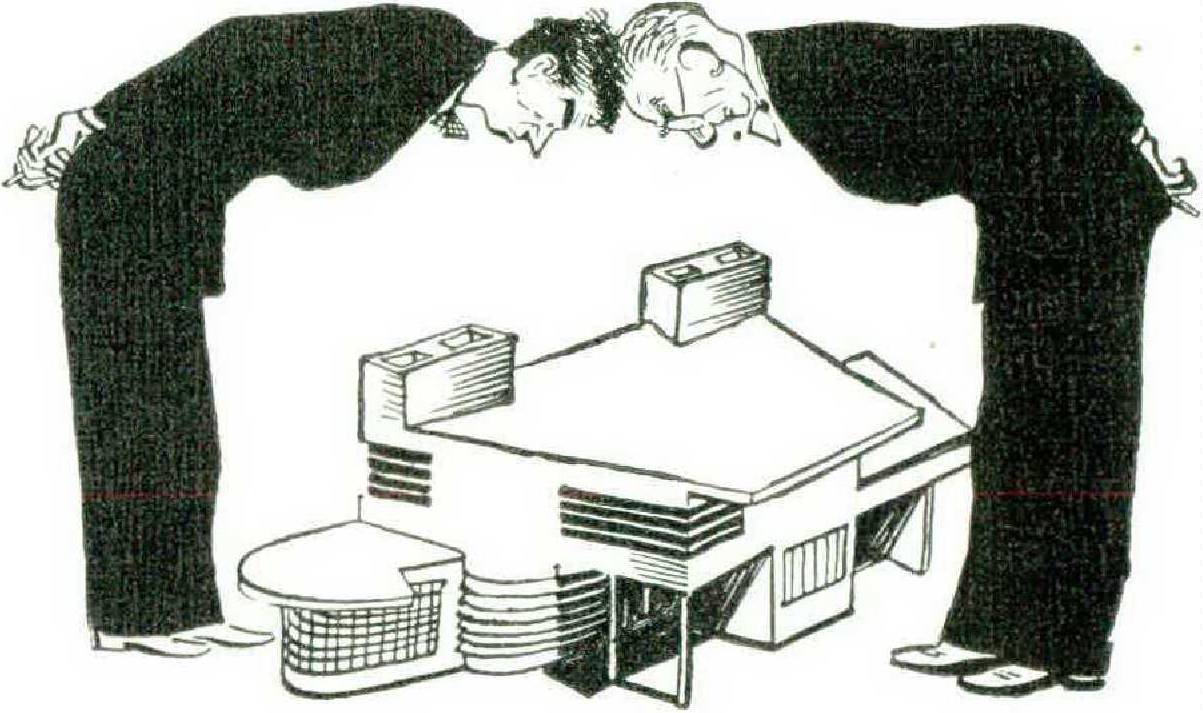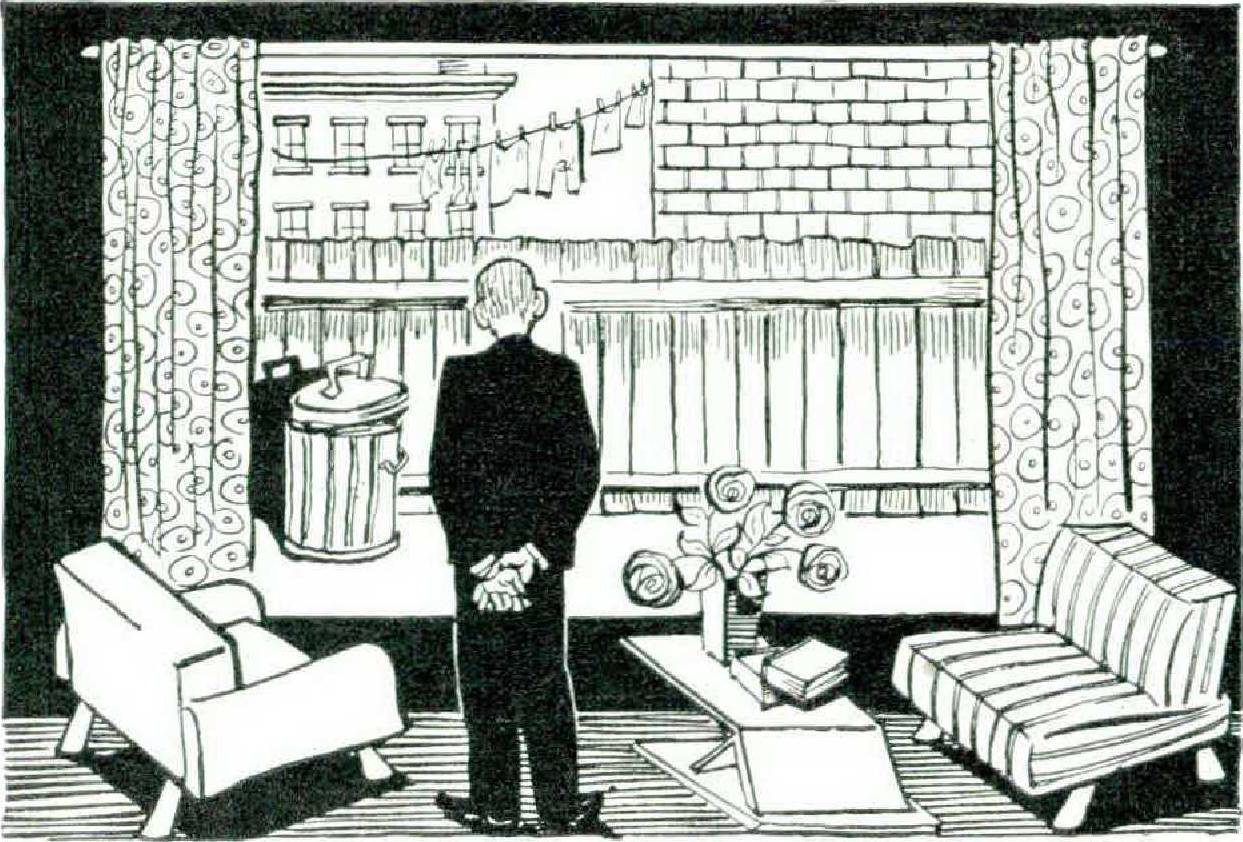


by CHARLES W. MORTON
WE SEEM to be poised, at the moment, in one of those uncomfortable intervals of transition between two civilizations, the stuff that Arnold Toynbee writes books about — ave atque vale, on with the new, and so forth. We know an awful lot, and the question is what, if anything, to do with it. The old tale about the book agent who called on the Vermont farmer sums it up well enough: —
“If you read these books you’ll learn how to farm better,” the salesman argued.
“Shucks,” quoth the rustic, “I ain’t farmin’ as good as I know how to now.”
It reminds me of the wistful spate of articles about American railroads which appeared earlier this year. All the editors must have been struck simultaneously by the belief that the railroads are not so bad as Chesapeake’s Robert Young says they are, and I found myself reading about playroom cars for the little folks, Ritz café and night-club effects, scenic cupolas in the roof, airy bedrooms en suite, and everything but a Pompeian pool and Finnish baths. It was a magazine writer who sounded a word of caution. Two hundred miles an hour train speeds were being talked up, he acknowledged, but this was really pretty fast, perhaps too fast. True, some of the airplanes did it. But why not, for the present, take a comfortable train speed of a hundred miles an hour? Let’s dream about the 100 m.p.h. train for a few paragraphs and postpone 200 m.p.h. Meanwhile, the Pennsylvania Railroad, he boasted, already has a train, the Congressional Limited, that actually runs on a schedule of sixty miles an hour!
The same kind of hiatus confronts us in housing. We enjoy reading about the globular aluminum house with pie-shaped rooms, revolving on its foundation mast and warmed by solar rays for only a few cents a day. These houses are so inexpensive — $6500, I believe — that I should have expected to see them mushrooming all over the countryside by this time. I have yet to see one anywhere.


Even the old-fashioned “modern house,” with its glass facade — through which the neighbors can scrutinize every grease spot on the chatelaine’s house dress — is a bit slow in the post-war development. This kind of house runs the risk of becoming out of date before it ever existed, unless the small contractors start catching up with the picture magazines. It’s later than they think. It has been some years now since we first saw the house with Pullman-berth guest alcove, the three-passenger bathroom, and the “dining area” device by which the family was supposed to be able to eat in the living room, or maybe in the kitchen, without quite realizing what it was doing. But so far, the nearest approach to all this that I have seen is those one-room New York apartments, reared in the twenties, with a gas plate suspended over the bathtub, a refrigerator big enough to hold two chops and a bottle of Coca-Cola, and an all-purpose closet containing the bed, clothing, dishes, the main supply of Coca-Cola, and everything else that the family owned. Most of it would fall out on the head of whoever opened the door. The occupants, however, were fond of explaining how convenient everything was, and were always charmed by the “view.”
Cruising around with a friend who was househunting, we stopped to inspect a property. About half a block away was a “modern” house. In the city this means an arrangement of horizontal slab effects, a certain amount of tarnished chromium, and a garage where one would ordinarily expect to ring the front doorbell. The main feature is usually a huge plate-glass window.
My friend started off down the street towards the “modern” house. “That’s not the one,” I told him.
“I know it,” he replied. With an air of great assurance, he added, “I just want to look in the big window that I know will be there and see the lady of the house, busy with her accounts.”
The confidence with which my friend declared himself was such that I accompanied him. We walked on down the street and, sure enough, there was the lady of the house, on full exhibition in her living room, and she was at her desk and she was indubitably busy with her accounts.
The modern house is thus primarily a visual challenge. It clamors to be looked at, whether from the street, outside or by conscientious inspection within. It must be of a piece, modern to the last sink stopper, light switch, or shoe cabinet. No Utter of garden hose, children’s vehicles, defunct electrical gadgets, snow shovels, picnic kits, and such can offend the eye in basement or garage. Permanently on display, the house must never expose an unmade bed or indeed anything that resembles a bed with sheets and pillowcases. All beds must look like sofas under their tufted or quilted or hand-loomed coverings, and no one ever removes these and crawls in and goes to sleep. The bathrooms show no signs of use, the kitchen no symptoms that food was ever prepared there.
The struggle between the old and the new reaches its greatest intensity in the kitchen. Here is a house, one gathers, whose occupants have been purged of earthy needs. Living in a semi-automatic world, they spend their energies on the fine arts and large affairs of national policy. They cook not, neither do they wash and wipe. Everything is “put away” behind inscrutable cupboard doors. Refrigerator, stove, sink, food freezer, laundry machinery, and broom closet are indistinguishable one from another. No stranger could bring together a lemon, paring knife, strainer, squeezer, receptacle, ice cubes, and workboard without a set of architect’s drawings.
What horrid sights the cupboard doors conceal we can only conjecture — scorched aluminum, unscoured skillets, sticky jam jars, potlids, and nests of bowls that no longer nestle. This is the debris of the bygone era, still bugging the gears of the machine age. Against it, architect and industrialist have striven with the best of modern technology.
Yet, in my fully mechanized household, the residue of egg on a breakfast dish is still removed each day by a human hand — my own.
